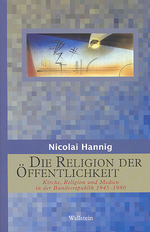
| Autor(en): | Hannig, Nicolai |
| Titel: | Die Religion der Öffentlichkeit. Kirche, Religion und Medien in der Bundesrepublik 1945-1980 |
| Reihe: | Geschichte der Religion in der Neuzeit 3 |
| Ort: | Göttingen |
| Verlag: | Wallstein Verlag |
| Jahr: | 2010 |
| ISBN: | 978-3-8353-0799-5 |
| Umfang/Preis: | 454 S. |
Rezensiert für infoclio.ch und H-Soz-Kult von:
Chris Dols
E-Mail: </>
In the second half of the 1960s, journalists in the Federal Republic of Germany, striving to unmask ideologies and break taboos, increasingly found their way to pollsters and their technologies. Striking is a project commissioned by the leading magazine Der Spiegel at the Emnid-Institute. In the immediate aftermath of the Second Vatican Council (1962–1965), this institute investigated «what the Germans believe in and how they live with their Church or without a Church at all». The outcomes of the research were published late 1967, in an editorial. One intriguing graph in particular – picturing a dropping line against the background of a stained-glass window which showed a religious theme – seemed to brilliantly capture the notion of religious indifferentism: whereas 97 percent of the Germans was baptized and 86 percent prayed, only 68 percent believed in God and 34 percent in hell. Referring to such «hard facts», journalists of Der Spiegel claimed that the time of classic religious values was definitely over.
These and many other interesting cases can be found in Nicolai Hannig’s thorough and yet readable book on Church, religion, and media in the Federal Republic. His main argument is that the changes that occurred in these domains between 1945 and 1980 were entangled. Hannig builds on recent research on media – treating journalists as agents of change – and religion – portraying transformation rather than decline – to analyse these interconnections. He also uses Pierre Bourdieu’s field theory and integrates an impressing array of primary sources into his analysis: from oral history and magzine articles to radio shows and letters from Church officials. One of the main analytical concepts is what Hannig has labelled as «medialisation of religion» (Medialisierung des Religiösen). This concept is meant to elucidate the growing presence of religion in the public sphere, as communicated by media in the second half of the twentieth century. Convincingly, Hannig demonstrates that journalists changed both the content and meaning of notions such as «religion» and «Church». Powerful and mighty as they became, they gave the microphone to specific individuals and simply ignored other persons.
With regard to Church, religion, and media, Hannig argues, three periods can be distinguished. In the years 1945 to 1958, the years of reconstruction, Church leaders tried their very best to rechristianise society (chapter II). Media, of which many were embedded in traditional ecclesiastical structures, served as an instrument to turn this rather ambitious goal into reality. Authorities such as bishops and the pope stayed as good as unchallenged. Journalists, perceiving Church and religion as valuable parts of society, often communicated biblical-theological themes and then tried to historisise these themes by means of pseudo-scientific evidence. In the years 1958 to 1972, the tide changed dramatically (chapters III and IV). Journalists broke away from the traditional ecclesiastical framework and switched roles: from loyal allies they became oppositional partners. Especially younger and conflict-orientated journalists, born in and after the 1920s, focused on highly controversial issues such as sexuality, opposed «old», «fake» and «useless» to «new», «authentic», and «useful», and stimulated cultural reform. Ultimately, in the years 1972 to 1980, journalists came to adress esoteric beliefs and religious pluralism (chapter V). To a considerable degree, they contributed to the rise of individuality as an important value of modern society.
Although this is a thought-provoking monograph in many respects, imperfections can be identified as well. As exemplified by Dutch history, one of the key aspects of the «medialisation of religion» was the battle for the production and communication of certain discourses. Connected to Bourdieu’s field theory, this aspect could have been worked into the analysis in a more coherent and explicit way, leading to a broader understanding of when, how, and why various persons deployed specific strategies and took in specific positions in the religious fields. The journalists themselves could also have been examined more intensively. Although a great deal of attention has been paid to people like Rudolf Augstein, Hannig’s main argument could have benefited more from the biographical approach, also taking gender into account. Yet, these clues for further research are provided by a fascinating book that definitely deserves wide readership amongst academics, both within and beyond the German borders.